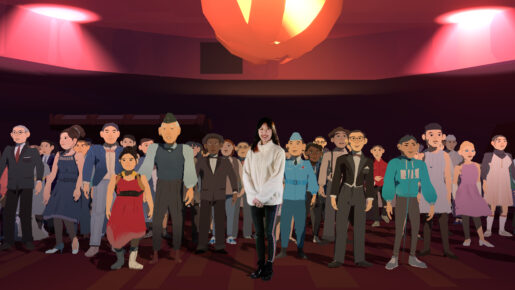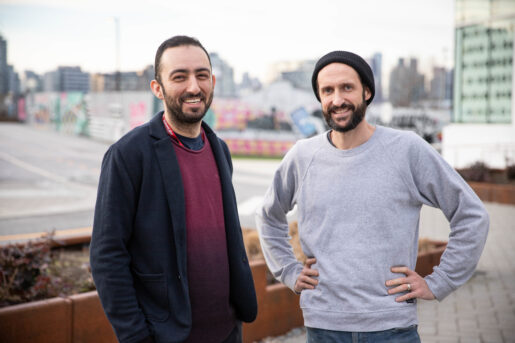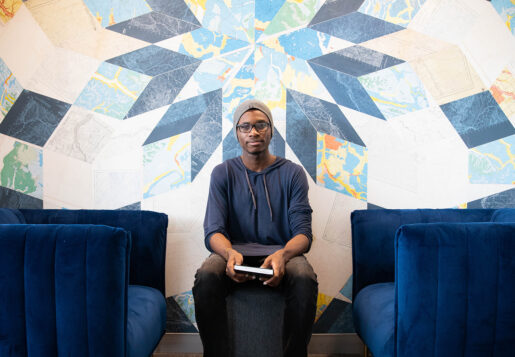Students Learn Cutting-Edge Pre-Visualization Techniques on New Lauren Marsden Film
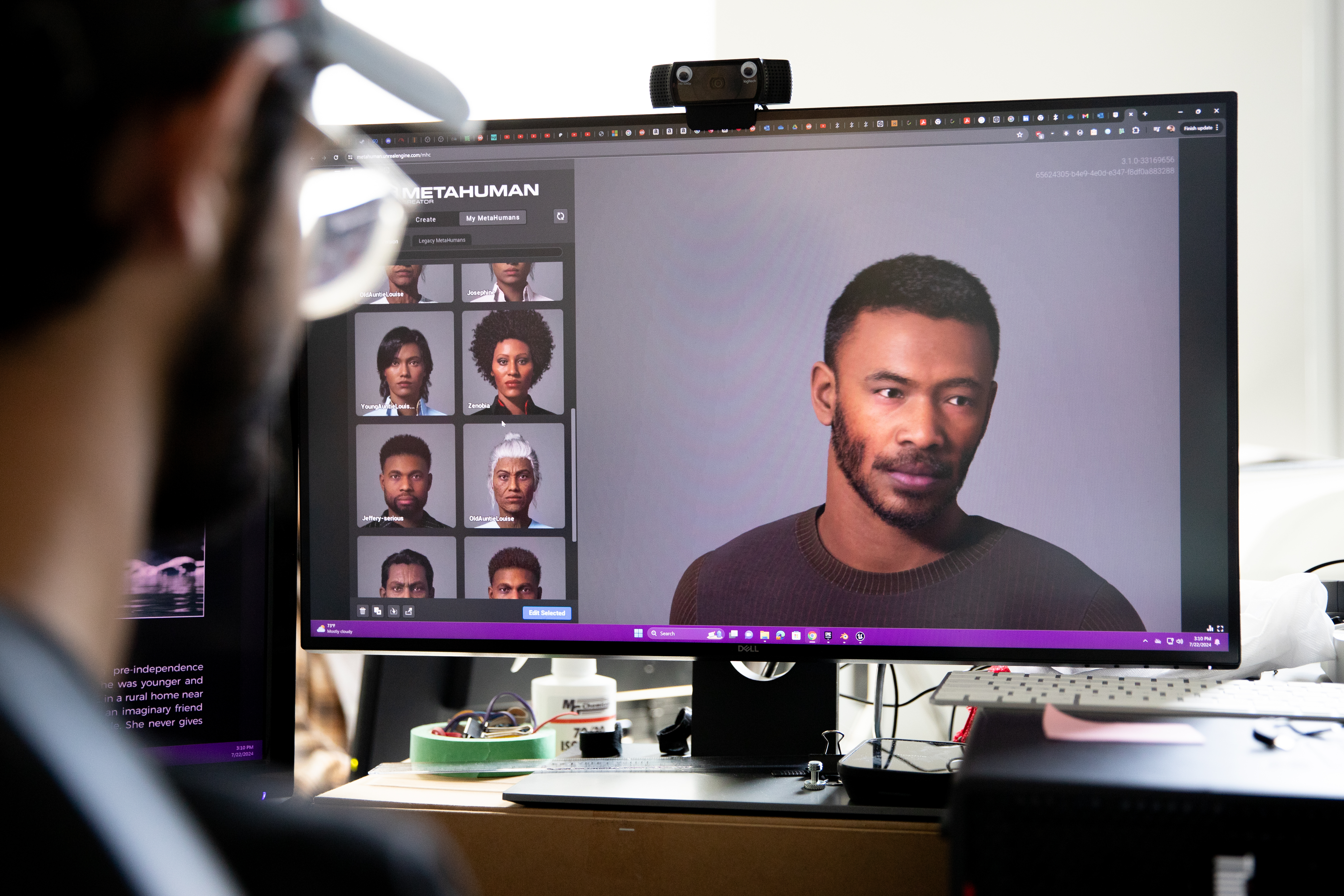
Master of Design student Asad Aftab works on character modelling for use in pre-visualization for artist and ECU faculty member Lauren Marsden’s film in development, Mama D’Lo. (Photo by Perrin Grauer)
Posted on
The artist and ECU faculty member has been leading a group of student researchers to develop virtual pre-production assets for her film in development, Mama D’Lo.
A team of student researchers at the Basically Good Media Lab (BGML) at Emily Carr University of Art + Design (ECU) is using open-source software to pre-visualize scenes for a film in development by artist and faculty member Lauren Marsden.
In addition to providing work experience, Lauren says the project is piloting workflows to equip students with cutting-edge, industry-standard skills.
“I’m interested in how we can make this type of project pedagogical,” Lauren says. “If we can prototype a studio for pre-visualization, we could have local producers working with students. But more than that, we can make this a part of meaningful skill development for students, which they can add to their portfolios.”
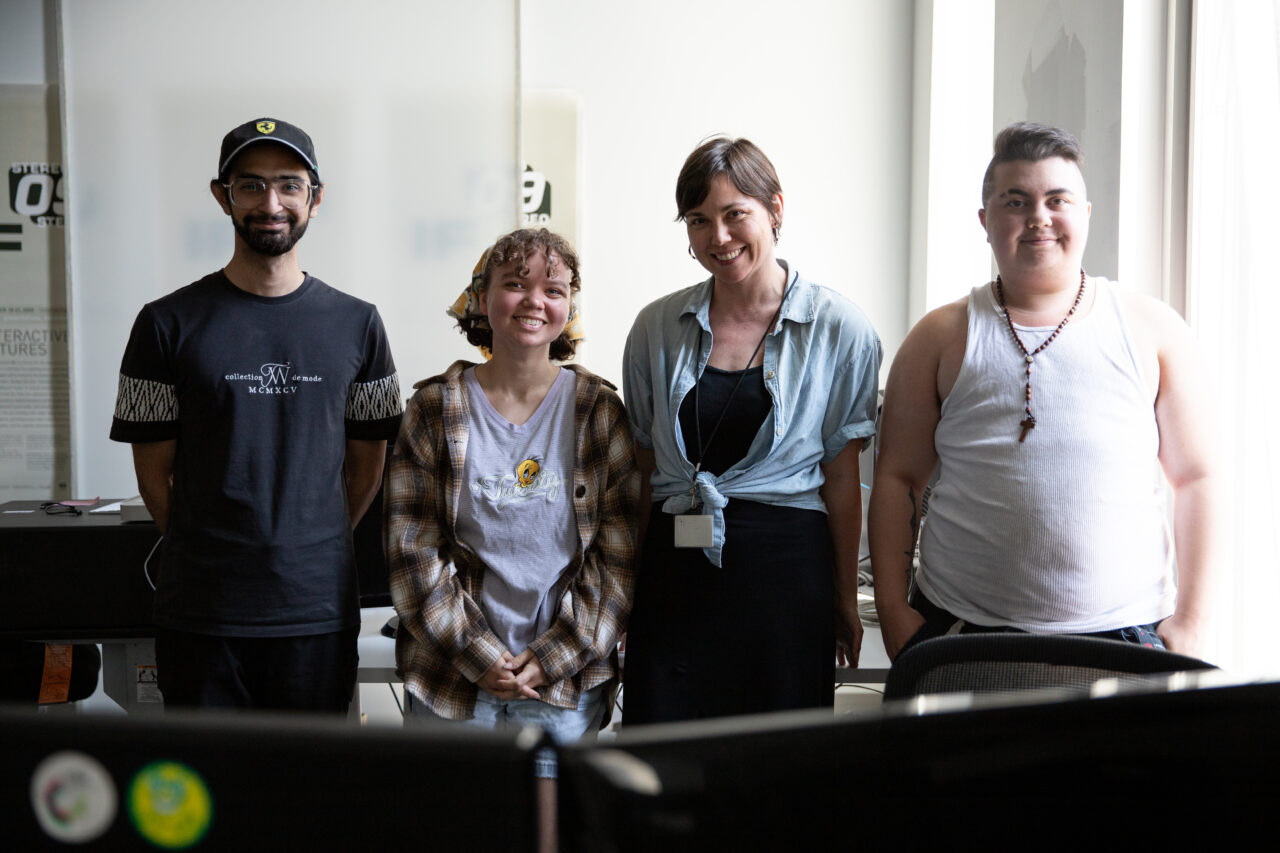
ECU students Asad Aftab and Skye Allen, artist and ECU faculty member Lauren Marsden, and 3D animator Dante Gorn in the Basically Good Media Lab at ECU. (Photo by Perrin Grauer)
Lauren and her team are part of the Virtual Planning and Pre-visualization (VPP) Studio, a project aimed at preparing students “for new and evolving production standards in the film industry, which are increasingly turning towards virtual planning and pre-visualization models.”
The VPP Studio includes student researchers Asad Aftab (MDes 2025), Skye Allen (BMA 2025), Aranza Berges (BMA 2025) and Dante Gorn (BMA 2024). It is co-led by faculty member Allison Hrabliuk with support from faculty member Peter Bussigel and research technician Sean Arden. The VPP Studio is funded by an SSHRC Institutional Grant.
Pre-visualization (previs) is the practice of visualizing scenes, sequences, characters and camera movements before filming begins. In recent years, filmmakers have begun to adopt the use of 3D rendering programs to produce detailed virtual environments to this end. Such strategies have been used to wide acclaim on big-budget features such as The Mandalorian, The Batman and Dune.
The VPP Studio is putting these techniques to work in support of Mama D’Lo, a feature film written and directed by Lauren. The queer eco-fantasy will be shot on location in Trinidad & Tobago, where Lauren’s family has its roots. Using hundreds of reference photos from the film’s locations, the team is using previs to map out roughly a dozen key scenes, chosen for their diversity and potential production challenges.

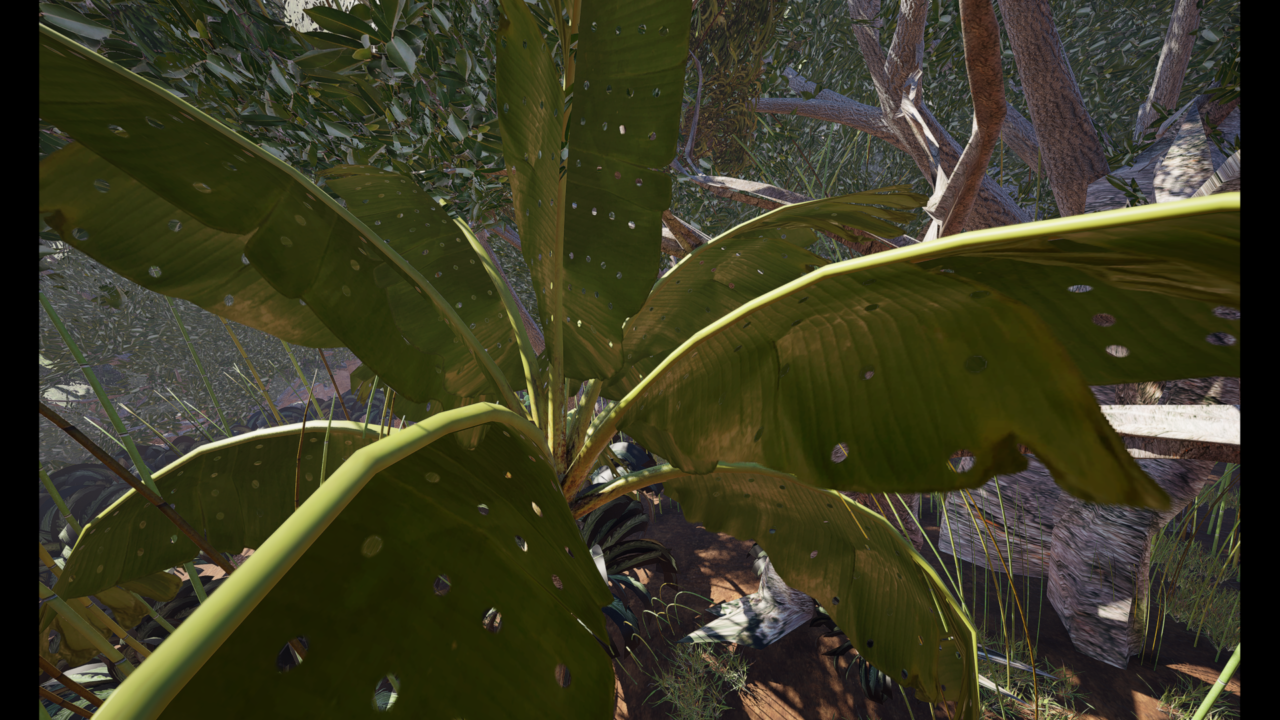
Using hundreds of reference photos from the film’s locations, the VPP Studio team is using pre-visualization to map out key scenes, chosen for their diversity and potential production challenges. (Still frames from Mama D'Lo pre-visualization courtesy Lauren Marsden)
Animator Dante Gorn gained a working understanding of previs during his time in the 3D Computer Animation program. He says the VPP Studio has helped him further hone skills in modelling, texturing, VFX, lighting and rendering.
“People in this industry switch between roles all the time and you never really know what opportunities you might get,” he says. “So, it is good to learn as many parts of the pipeline as possible, especially if I ever want to do freelancing or solo projects. It is a lot easier to do those things if you can be a generalist.”
Master of Design student Asad Aftab has been primarily responsible for character modelling. He and Lauren quickly discovered they needed to create their own bespoke assets — such as afro-textured hair and hairstyles— for representing people of colour in the project, since many open-source programs offer limited options.
“We’re genuinely pushing these programs to the absolute limit of what is possible,” he says, adding the experience provides a singular opportunity to work on an industry project while still in school. “What we’re doing here is already happening in film. So, this is a good steppingstone. It’s a real-world application of some of the things you learn in academia. And it’s a chance for me to apply that skill set to something I’m passionate about.”

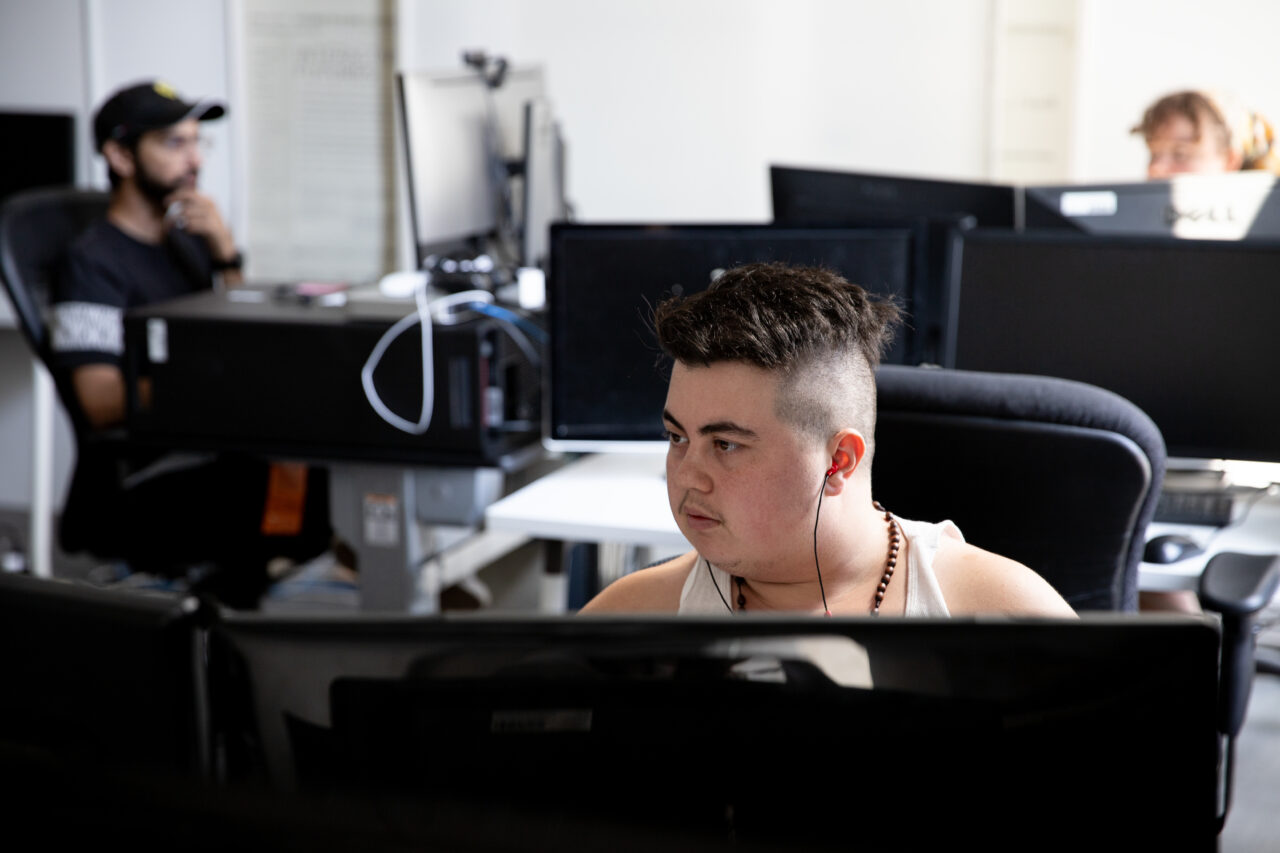
Skye Allen (top) and Dante Gorn at work on Mama D’Lo. Project lead Lauren Marsden says that by prototype a studio for pre-visualization, “we can make this apart of meaningful skill development for students, which they can add to their portfolios.” (Photo by Perrin Grauer)
2D + Experimental Animation student Skye Allen notes animated films are increasingly combining 2D and 3D techniques. Skye says working on Mama D’Lo is an ideal opportunity to diversify her toolkit with the goal of working in mixed-media animation after graduation.
“I’m really interested in using 3D previs to help plan complex sequences, which can be difficult to do using frame-by-frame drawing,” she says. “That’s very similar to what we’re doing here: laying things out in 3D and then figuring out what the shots will look like for live action. I’ve found it super exciting.”
Lauren notes Mama D’Lo is on track to be the first green-certified feature production in the Caribbean region. But she adds this indie-scale application of previs demonstrates a more sustainable model for films of all scales.
For instance, film shoots are notoriously resource-intensive and leave enormous carbon footprints. But previs helps filmmakers anticipate and solve problems ahead of on-location film days which require cast, crews and high-carbon activities including transportation, equipment, fuel and food.
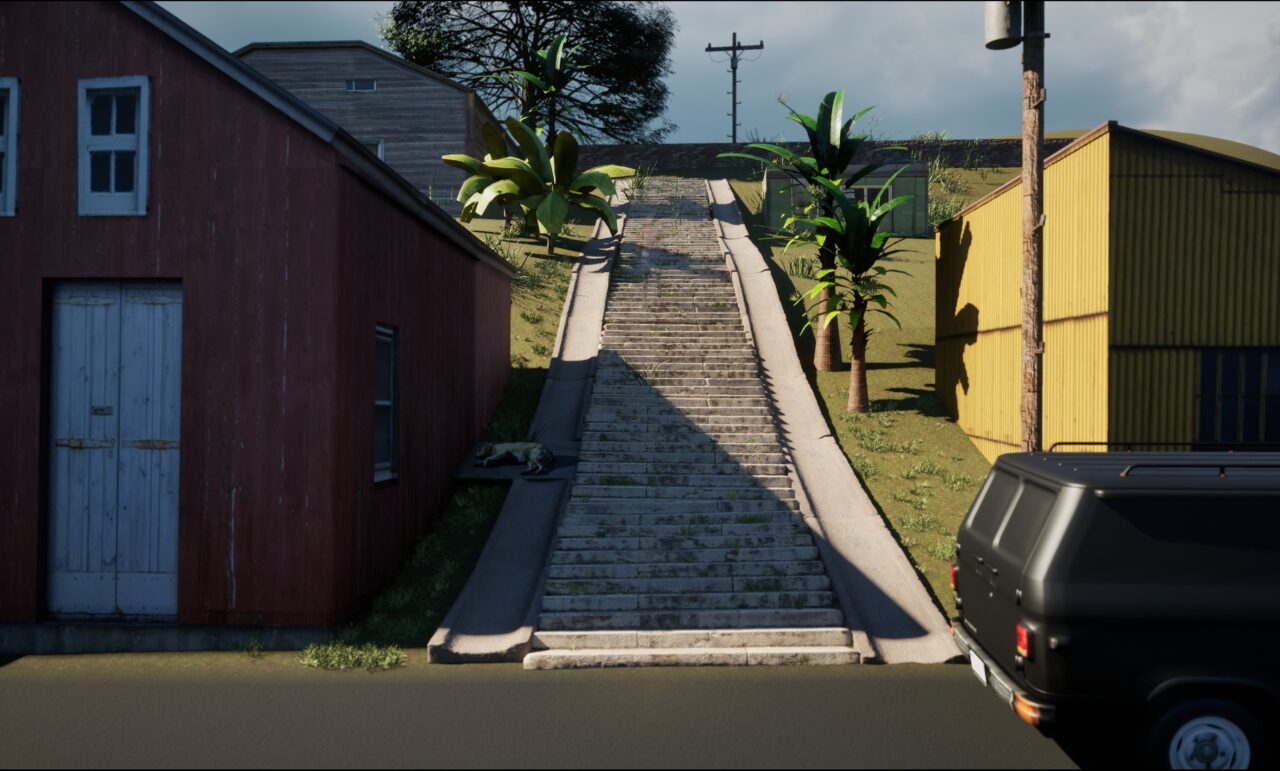

“How can we enter these spaces with minimal disruption? And how is this project giving back and not just extracting?” Lauren says of the broader questions behind the project. (Still frames from Mama D'Lo pre-visualization courtesy Lauren Marsden)
Lauren also intends to pilot a model for channeling film revenue into projects such as land stewardship in the communities where the film is shot.
Such concerns are crucial since existing standards for environmental and social impact — including those programs that incentivize “green” productions — are biased toward developed, Westernized conditions.
“It’s about finding a balance between the value of storytelling and minimizing harm,” she says. “Ecological storytelling is important because it can reach a big audience. But then, what is the carbon cost of that? How can we enter these spaces with minimal disruption? And how is this project giving back and not just extracting?”
Visit Lauren’s website to learn more about her work.
